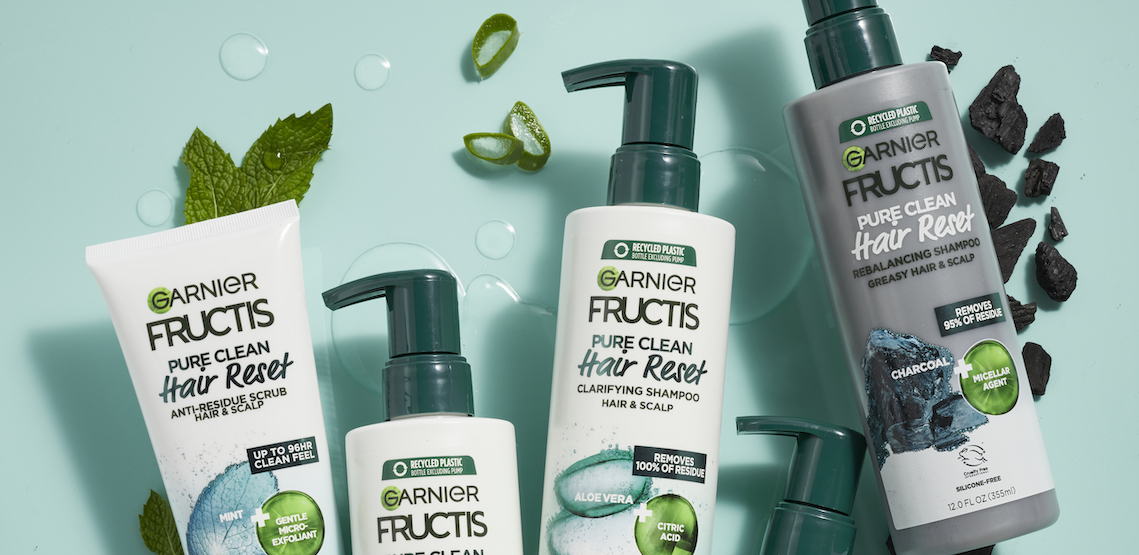This week I’m taking a look at Walmart and Garnier’s new exclusive scalp-focused product collection and how this adds to Walmart’s larger Gen Z strategy.
Garnier and Walmart have teamed up on an exclusive hair care line focused on the scalp to attract Gen Z consumers.
Called the Garnier Fructis Pure Clean Hair Reset collection, the six-product collection includes three types of shampoo, a conditioner, a hair serum, and an “Anti-Residue” scalp scrub, all for $6.97 each. The popularity and rise of skin-care products have changed how Americans think about their overall skin health, including the scalp.
“There is an increasing interest for deep cleaning,” said Alanna McDonald, L’Oreal USA president of Garnier, Maybelline New York and Essie. “The [increase of dry shampoo] is partly amplified because of Zoom. You can look really good on screen, and then it’s time to reset and get that deep clean when you’re hopping into the shower.”
Thus, the co-creation of this hair and scalp product line focuses on hair and scalp residue like pollution, dirt, oil and styling product build-up. The Garnier Fructis Pure Clean Hair Reset collection is available exclusively at Walmart, in more than 4,200 stores, and at Walmart.com.
For Walmart, this partnership adds to its exclusive-collection strategy to attract Gen Z customers, including beauty brand Uoma by Sharon C, P&G hair care brand Nou and skin-care brand DermaGeek and now Garnier. Additionally, when Gen Z skin-care brand Bubble expanded to its first brick-and-mortar retail in July, it joined Walmart in 3,800 doors. According to the annual Piper Sandler Taking Stock with Teens survey, Walmart is the No. 4 most popular beauty retail destination. Garnier also over-indexes among Gen Z and younger millennials, according to McDonald.
“It was important for us to collaborate on an exclusive product line to meet the needs of our Gen Z customers,” said Musab Balbale, Walmart U.S. vp of beauty. “The launch of the Fructis Pure Clean Hair Reset collection expands our selection of on-trend products with sophisticated formulas and ingredients that deliver impressive hair and scalp benefits at an incredible value.”
Garnier’s close relationship with Walmart stretches back several years. When Garnier sought to bring personalization into the in-store experience in 2019, it debuted a virtual shade-selector tool (powered by ModiFace) for its at-home hair dyes with Walmart.
L’Oréal Group, which reported its first-half year earnings results in July, said that the consumer products division where Garnier is nestled increased revenue by 20% compared to the same period in 2020. The consumer products division accounted for 21% of overall company sales, and the category of hair care itself accounted for 15% of sales, a 23% increase year-over-year. Garnier received a callout from Nicolas Hieronimus, L’Oréal Group CEO, during the earnings calls for its sustainability transformations and cruelty-free Leaping Bunny certification, which is “important to the Gen Zs around the world.”
McDonald says that Garnier will evaluate consumer reaction to the collection post-launch and whether sales are meeting expectations for both Garnier and Walmart. McDonald said there has always been a retailer appetite for exclusive product opportunities, but strategies and execution have likely adjusted due to Covid-19.
“Exclusive products and being able to help retailers differentiate is also part of the learning journey that we’re on,” she said. “We are broadly available, so much of our portfolio remains consistent across retailers, but we’re also looking at how to supplement that with some differentiation and uniqueness [to retailers].”
Garnier and Walmart will jointly promote the collection through TikTok, Facebook, and Instagram to drive people to Walmart.com and shop in-store. In September, Garnier also introduced a digital zine that takes readers through each launch and includes product information to introduce the new products. Garnier plans to showcase regimens for different scalp types for one week across Instagram and TikTok. It is also gifting products to an undisclosed number of influencers who have opted in to drive trial and awareness. On Instagram, there will be a giveaway contest in October. During the L’Oréal Group’s recent earnings call, Christophe Babule, L’Oréal Group CFO, said the company invested heavily in digital media expenses, particularly influencers, social networks, and video and display ads. He said that all-in-all digital media represented 72% of total media spend, versus 59% during the same period in 2020.
Walmart has also invested heavily into TikTok through both effort and money. According to a September story from Digiday, Walmart launched a TikTok home channel called 4Walls to reach Gen Zers shopping for their first home, apartments and college dorms. It has already amassed over 130,000 followers, while its main brand account (@Walmart) has 1 million followers and launched in 2019. Per Digiday, citing social intelligence and analytics platform BrandTotal data, at least half of Walmart’s digital ad dollars go toward Facebook. The remaining budget is spread across YouTube, Instagram, Twitter and LinkedIn, but not TikTok as BrandTotal doesn’t track TikTok spending. Walmart previously planned to buy TikTok’s U.S. operations through a joint venture with Oracle Corp., but those plans fell through in February. Walmart plans to include the collection as a key part of its Fall Beauty communication campaign across its own digital channels, which in the past included influencers and livestreaming on TikTok.
“By working together to create something that both [Walmart and Garnier] believe in, it not only reinforces our partnership but hopefully works toward solutions that will delight shoppers in-store,” said McDonald.
Inside our coverage
Ayurvedic beauty gains traction.
Alpyn Beauty joins all Sephora doors.
Olaplex goes public at a $14 billion valuation.
JCPenney looks to fill its Sephora gap.
What we’re reading
Unilever wants to partner with beauty startups.
Amazon is trying to get ahead of holiday shopping.
The Estée Lauder Companies gets out of fragrance licensing.




